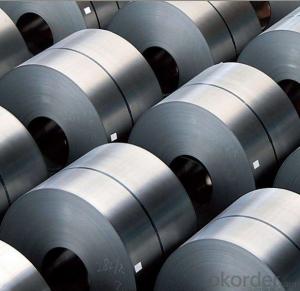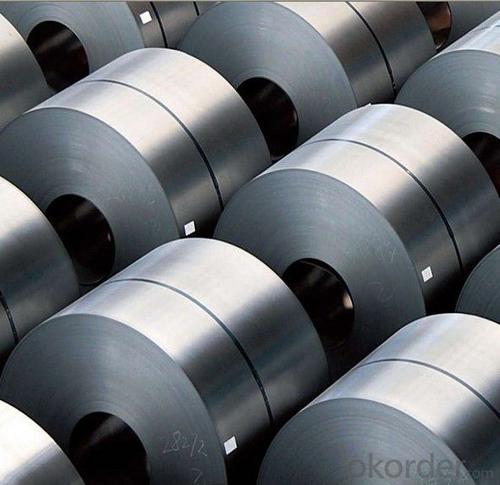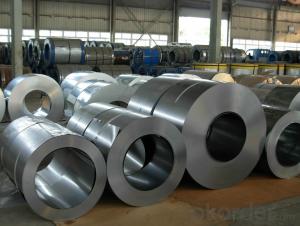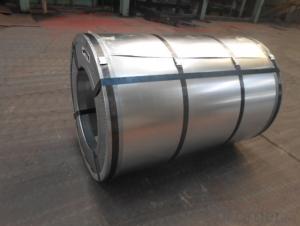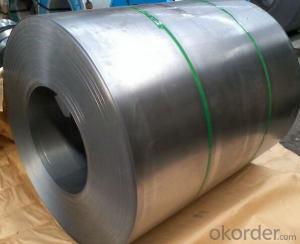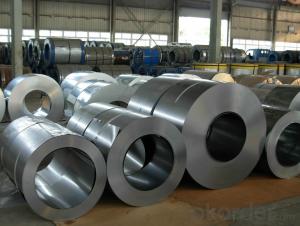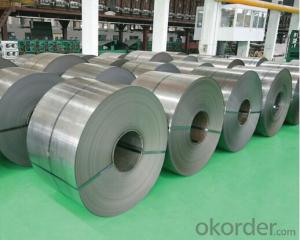Cold Rolled Steel Sheet in Coil/High Quality/low Price
- Loading Port:
- China main port
- Payment Terms:
- TT OR LC
- Min Order Qty:
- 12 m.t.
- Supply Capability:
- 50000 m.t./month
OKorder Service Pledge
OKorder Financial Service
You Might Also Like
Specification
Product Description
Commodity | Cold Rolled Steel Coils | |
Raw material | SGCC, SPCC, DC51D, SGHC,A653 | |
Certificate | ISO9001.ISO14001.OHSAS18001 | |
Thickness | 0.15mm-5mm | |
Width | 1250mm or under | |
Tolerance | thickness+/-0.01mm | |
Surface treatment | galvanized / galvalumized steel sheets | |
Zinc coating | 40-180g | |
Type of coating structure | 2/1 or 2/2 coating, or customized | |
MOQ | 25 tons | |
Packaging | Seaworthy standard packaging or as customed | |
Delivery | 10-15 days after receiving the prepayment | |
Application | Building industry ,structural use, roofing, commercial use ,household appliance, industry facilities,office buildings | |
1)Thickness: 0.4-3.0mm
2)Width: 600/1000/1250/1500mm or customized
3)Grade: SPCC, SPCD, SPCE, DX51D+Z, DC01-06, ST12, 170P1, HC380LA, SPHC, Super deep drawing
4)Standard: JIS G3141-1996, EN 10131-2006, DIN EN 1002
5)Weight of Cold Rolled Coil : 3-15MT
6)Surface Treatment: Galvanized or Oil
7)Technique: Cold rolled
8)Edge: Cut edge or Mill
9)Original place: Tianjin, China
10)Advantage of Cold Rolled Coil :
High quality in flatness, brightness and straightness, and be qualified in both chemical compositions and mechanical properties.
11) Package of Cold Rolled Coil : Strapped with min three strapping strips, covered by anti-water paper and plastic film, fixed on the iron or wooden pallets by strapping strips and covered by plastic bag to prevent damage from transportation.
12)Applications for Cold Rolled Coil :(1) For the further producing of hot dip galvanized steel products or Prime Pre-painted Steel Coil
(2) Cold rolled Steel Coil: Auto manufacture, Oil drum, Transformer's tank panel, Furniture, bicycle, construction, battery case, industrial machine, etc.
13)Process of Cold Rolled Coil :
Pickling: To clean the dust and rust points on the surface.
Cold Rolling: Digital rolling control system produces minimum thickness tolerance, helps to prevent twist and improve straightness.
Slitting: Precise slitting machinery helps control the best width tolerance and avoid camber or cracker.

- Q: I thought it was STAINLESS STEEL! I have stainless steel can openers spatulas that are rusty. What's up with that? did you know that braces on people's teeth are made of stainless steel? That's why they call people metal-mouth. I used to have braces.
- You can rub the rust off with anything, from steel wool to Ajax. Although if you've previously used steel wool to clean it, that could be why it rusts. We had that problem manufacturing stainless steel railing and had to put it together on an aluminum table and polish welds with grinding wheels that never touched steel. What rusts are steel particles picked up on the stainless surface. Another possibility is that some stainless is more magnetic and usually also heat-treatable. It has just enough chrome in it to classify as stainless but can get minor surface rust. Not nearly as much as plain steel, though. Use a scouring powder like Zud or Barkeepers Friend and a cloth or sponge to polish if it's a sheetmetal surface rather than a bar grille, because these have oxalic acid and no bleach. They don't leave corrosive traces of chlorine behind. In fact, oxalic acid reduces rust to iron powder. Which is really neat if you need to clean a small rusty item--stir one of these powders into water, drop in the rusty piece and check it from time to time. Rinse off any abrasive powder, dry it well and oil it. When the rust is gone, it leaves a fine matte finish behind.
- Q: How are steel coils used in the manufacturing of steel drums?
- Steel coils are used in the manufacturing of steel drums by being cut into sheets and then formed into cylindrical shapes, which serve as the main body of the drum. These coils provide the necessary strength and durability required for holding and transporting various materials.
- Q: What are the common coil widths and thickness combinations available for steel coils?
- Common coil widths for steel coils range from 600mm to 2000mm, while common thickness combinations vary from 0.4mm to 3.0mm.
- Q: is a 1962 steel penny worth anything?
- Don't know that they're worth a whole lot at this time, but hold on to them. They may be at some point, and what's the loss if you keep them? May be worth something to the kids or grandkids?
- Q: How are steel coils used in the production of pressure vessels?
- Steel coils are used in the production of pressure vessels as they provide a strong and durable material for constructing the vessel's shell. The coils are formed into cylindrical shapes and welded together to create the vessel's body. This ensures that the vessel can withstand the high pressures it is designed to hold, making steel coils an essential component in pressure vessel manufacturing.
- Q: I'm pretty sure that this topic has been beaten to death by now. But, I still can't get a definite answer. With stainless steel, you get better corrosion resistance, and you will hold and edge longer. With carbon steel, you will hold a sharper edge, and you could forge a knife blade longer than 2 ft without breakage. I'm personally a fan of stainless steel ( the 440 grade stuff ), just because it seems to hold up to use and abuse better in the long run. HOWEVER, I have NEVER had a factory made knife break on me. I don't think that they would try to sell you a knife that didn't do what it was meant to do, at least to a reasonable degree. (I work for a living, and can't afford a custom $600 knife.) What do you think? Is this a pointless topic? Will there ever be a winner?
- I hate stainless steel! I hate shiny blades also! When I was a kid knifes were awesome! You could actually sharpen them! :) If we bought a new knife we would take an orange and slice it and leave the juice on the blade to purposefully darken it. If you had a shiny blade that looked like stainless you were not cool. :) I think most anyone who had an old knife from back in the 70's or before would agree that these new stainless knives are crap. I have not seen anything perform close to the old blades in stainless. Today I bought a case CV Sod Buster hoping it will perform like the old knives. What reading I have done the Chrome Vanadium is supposed to be like the old steel. I sure hope it is. Now to find some fruit to get rid of this annoying shiny blade! :)
- Q: How do steel coils affect the quality of finished products?
- The quality of finished products in various industries can be greatly influenced by steel coils. Dimensional accuracy and consistency are key factors that determine the impact of steel coils on product quality. When steel coils are not properly manufactured or have irregular dimensions, it can cause issues in the production process and result in finished products that do not meet the desired specifications. Moreover, the final appearance and performance of finished products are heavily dependent on the surface quality of steel coils. Defects such as scratches, rust, or unevenness in the coils can have a negative impact on the aesthetic appeal of the products, making them less desirable to customers. Additionally, these defects can compromise the functionality and durability of the finished products, potentially leading to failures or a reduced lifespan. The mechanical properties of steel coils also play a crucial role in determining the quality of finished products. Coils with inconsistent or inadequate mechanical properties can compromise the strength, toughness, and overall performance of the end products. This is especially important in industries like automotive or construction, where strength and reliability are of utmost importance. The use of steel coils with incorrect mechanical properties can lead to safety hazards or structural failures. Furthermore, the chemical composition of steel coils can have a significant impact on the quality of finished products. The presence of impurities or variations in the alloying elements can affect the material's corrosion resistance, weldability, and other important properties. This, in turn, can affect the longevity and functionality of the final products. In conclusion, steel coils have a significant influence on the quality of finished products. Their dimensional accuracy, surface quality, mechanical properties, and chemical composition all contribute to the overall performance, appearance, and durability of the end products. Therefore, it is essential to ensure that steel coils used in manufacturing processes meet the required standards to achieve high-quality finished products.
- Q: What are the different coil cutting machine options available for steel coils?
- There are several coil cutting machine options available for steel coils, each catering to different requirements and specifications. Some of the common options include: 1. Slitting Machine: This machine is used to slit the large steel coils into narrower strips or slits. It typically consists of a circular blade that moves across the width of the coil, cutting it into the desired widths. Slitting machines can handle a wide range of steel coil thicknesses and are commonly used in industries such as automotive, construction, and manufacturing. 2. Cut-to-Length Machine: This type of machine is used to cut steel coils into specific lengths. It is equipped with a shearing mechanism that cuts the coil based on the programmed length. Cut-to-length machines are particularly useful for applications where precise and consistent lengths are required, such as in the production of steel sheets or plates. 3. Rotary Shear Machine: A rotary shear machine is designed to cut steel coils into smaller pieces or squares. It utilizes a rotating drum with multiple cutting blades that shear the coil in a continuous process. This type of machine is often used in industries that require smaller steel pieces for further processing or assembly. 4. Guillotine Shear Machine: This machine is equipped with a large blade that moves vertically to cut steel coils. It is commonly used in applications where high precision and high-speed cutting are required. Guillotine shear machines can handle thicker steel coils and are often employed in heavy-duty industries such as shipbuilding and metal fabrication. 5. Laser Cutting Machine: Laser cutting machines offer a highly precise and versatile method for cutting steel coils. They use a focused laser beam to melt or vaporize the material, resulting in a clean and accurate cut. Laser cutting machines are suitable for a wide range of steel coil thicknesses and can handle complex shapes and patterns. These are just a few examples of the coil cutting machine options available for steel coils. The choice of machine depends on factors such as coil thickness, desired cutting precision, required output volume, and specific application requirements.
- Q: What are the different types of steel coil edge conditions?
- There exist various steel coil edge conditions, each tailored to specific needs and uses. The most prevalent categories are as follows: 1. Mill Edge: The default edge condition for hot-rolled steel coils, wherein the edges remain untouched after the rolling process. This condition is characterized by a slightly rough and uneven surface. 2. Slit Edge: Achieved by cutting the coil across its width to obtain narrower strips. This condition is typically smoother and more uniform than mill edge, making it ideal for applications requiring a clean and precise edge. 3. Trimmed Edge: Achieved by eliminating irregularities and imperfections from the coil's edges. This process yields a straight and smooth edge, suitable for applications necessitating a precise and uniform surface. 4. Deburred Edge: Created by removing burrs or sharp edges from the coil. Commonly used in safety-oriented applications to eliminate potential hazards associated with sharp edges. 5. Round Edge: Attained by rounding the corners of the coil. Often employed in applications requiring easy handling or when preventing damage to other materials or surfaces is crucial. 6. Slit and Deburred Edge: Combines the advantages of both slit and deburred edge conditions. Involves cutting the coil into narrower strips and subsequently removing any burrs or sharp edges, resulting in a clean and safe edge. Each of these edge conditions serves a distinct purpose and is selected based on the specific requirements of the application. By comprehending the various types of steel coil edge conditions, one can choose the most appropriate option to ensure optimal performance and safety.
- Q: How are steel coils inspected for yield strength?
- Steel coils are inspected for yield strength through a series of testing methods. The most common and widely used method is the tensile test. In this test, a small sample is taken from the steel coil and subjected to a controlled load until it reaches its yield point. During the tensile test, the sample is gradually stretched until it deforms and ultimately breaks. The load and elongation data are continuously recorded during this process. The yield strength is then determined by identifying the point on the stress-strain curve where the material begins to exhibit plastic deformation or permanent elongation. Another method used to inspect steel coils for yield strength is the hardness test. Hardness is often correlated with yield strength, and therefore, a hardness test can provide an estimation of the material's yield strength. This test involves measuring the resistance of the steel coil's surface to indentation or penetration using instruments like a Rockwell or Brinell hardness tester. Additionally, non-destructive testing methods such as ultrasonic testing and magnetic particle inspection can also be employed to evaluate yield strength. Ultrasonic testing involves the use of high-frequency sound waves to detect any internal defects or inconsistencies in the material's structure. Magnetic particle inspection, on the other hand, relies on the application of magnetic fields and the use of magnetic particles to identify surface cracks or defects. Overall, various testing methods are available to inspect steel coils for yield strength. These methods provide manufacturers and inspectors with valuable information about the quality and performance capabilities of the steel, ensuring that it meets the required standards and specifications.
Send your message to us
Cold Rolled Steel Sheet in Coil/High Quality/low Price
- Loading Port:
- China main port
- Payment Terms:
- TT OR LC
- Min Order Qty:
- 12 m.t.
- Supply Capability:
- 50000 m.t./month
OKorder Service Pledge
OKorder Financial Service
Similar products
Hot products
Hot Searches
Related keywords
